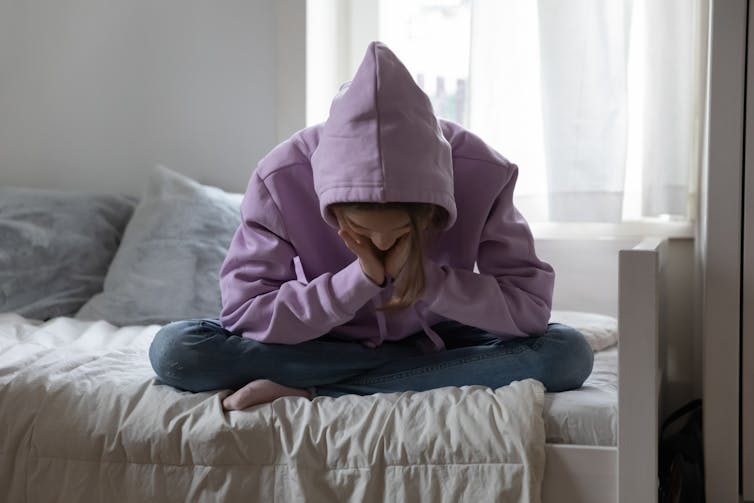Written by:
Amy-Leigh Rowe, University of Sydney; Lauren Gardner, University of Sydney, and Siobhan O’Dean, University of Sydney
If you experience trauma during childhood, there’s a greater chance you’ll use substances such as alcohol, tobacco and other drugs later. But what does the evidence say about vapes?
Our new study is the first to investigate the links between childhood trauma and vaping habits in Australian teens. Those who’d had traumatic experiences before the age of 12 were more likely to have tried vaping, vape regularly or intend to in the future.
Despite bans on importing and selling vapes containing nicotine, labelling loopholes have meant they’ve continued to be readily available. A study of 423 vapes confiscated from New South Wales retailers in 2022 found 98.8 per cent contained nicotine.
While quitting nicotine is challenging for most people, our research suggests young people with histories of trauma may face extra challenges – and require tailored support.
Trauma and substance use
For people who experience trauma in early life, the consequences can extend far beyond the event itself. Trauma is a form of psychological harm caused by experiences that pose a significant threat to your life or to others’ lives. These may include emotional, physical and sexual abuse, or exposure to natural disasters and serious accidents.
Research links childhood trauma to negative physical and mental health outcomes. This includes higher rates of substance use and addiction.
The reasons for this are complex and may involve a range of factors, including social and environmental influences. For example, young people who have experienced trauma are more likely to have been exposed to substance use by people around them.
But trauma also affects the brain’s development, and this may influence whether we are more likely to use substances.
Traumatic experiences can lead to greater impulsivity and risk-taking behaviour. Trauma can also disrupt how we deal with stress, heightening our response to future stressors.

Self-medication is risky for a developing brain
People who have experienced childhood trauma are more likely to have difficulty identifying, understanding and expressing emotions (known as alexithymia). This is why we often talk about substance use as self-medication – a way to cope with emotional pain and stress.
But self-medicating is particularly problematic for young people. The adolescent brain is still developing, so it is more susceptible to the harmful effects of nicotine, alcohol and other drugs.
Young people become addicted to nicotine faster than adults – and stronger cravings may make it harder for them to quit.
We found a link between early trauma and teen vaping
A handful of studies have found consistent links between childhood trauma and vaping. But research has focused mostly on adults, rather than asking teenagers about vape use. There was only one study about trauma and vaping in Australia and it looked at adult women.
But we know young people in Australia are being exposed to vapes early – and that the number of teens who vape is rising.
Our new study examined self-report surveys from 2,234 Year seven and eight students from 33 schools across New South Wales, Queensland and Western Australia, collected as part of the Health4Life study. The surveys assessed trauma history at age 12 and vape use three years later.
We found those who’ve had a traumatic experience by age 12 are more likely, at age 15, to say they’ve tried vaping (64 per cent), vape regularly (63 per cent) or intend to vape in the future (44 per cent).
Challenges for quitting
Our new findings highlight an even younger group of Australians at-risk for vaping and becoming addicted to nicotine. Many may already be addicted.
Nicotine is highly addictive and quitting can often take multiple attempts due to difficult withdrawal symptoms. People often require a combination of behavioural support – such as counselling – and pharmacological supports, which might include nicotine replacement therapy or therapeutic vapes.
Current guidelines for GPs highlight a lack of research about how to support adolescents to quit. Available evidence is based on research with adults or is focused on tobacco smoking.
New federal laws have made therapeutic vapes – those used to manage nicotine dependence – available with a prescription to those under 18. However, this is subject to state and territory laws.
Other challenges
Having a history of trauma can also compound the challenges of quitting.
We know family and social support are strong protective factors for young people – for example in seeking help to quit smoking.
But this support is less likely to be available to children who’ve experienced violence and abuse, given the most likely perpetrators are their own family.
Childhood trauma can also lead to distrust of health-care professionals.
Beyond GPs and counsellors, young people exposed to early trauma will likely need specialised psychological support to develop healthier coping strategies.

What young people need
We need a mix of universal and targeted prevention strategies.
In 2022-23 we developed a universal, school-based prevention program, known as the OurFutures Vaping Program. It is currently being evaluated among more than 5,000 students in New South Wales, Western Australia and Queensland, and refined in response to student and teacher feedback.
We also need strategies that recognise childhood trauma as a risk factor for vaping and focus on harm reduction. We need to do more to reduce rates of childhood trauma too, using evidence-based methods to disrupt cycles of abuse.
Consistent and culturally safe methods can help identify young people with trauma histories early and ensure they have access to comprehensive support and trauma-informed care.
Not all young people who are exposed to trauma will experience negative outcomes, but many will – and Australia needs to be better equipped to respond.
Amy-Leigh Rowe, Postdoctoral Researcher in Mental Health and Substance Abuse, University of Sydney; Lauren Gardner, Senior Research Fellow & Program Lead of School-Based Health Interventions, University of Sydney, and Siobhan O’Dean, Postdoctoral Research Associate, The Matilda Centre for Research in Mental Health and Substance Use, University of Sydney
This article is republished from The Conversation under a Creative Commons license. Read the original article.








